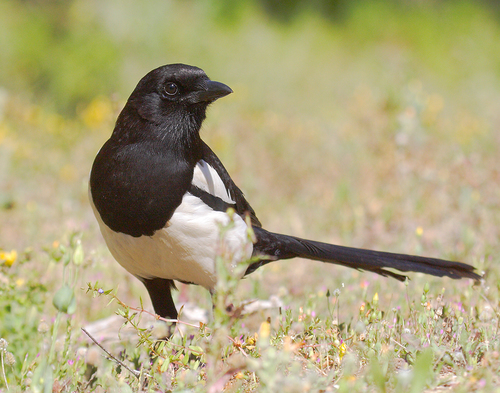
Eurasian Magpie
The Eurasian Magpie (Pica pica) is a highly recognizable and widespread bird species known for its striking black and white plumage, long tail, and distinctive chattering call. Belonging to the corvid family, which includes crows, ravens, and jays, magpies are renowned for their intelligence, adaptability, and complex social behaviors. They play a significant role in their ecosystems as both predators and scavengers, influencing the populations of insects, small animals, and carrion. Culturally, magpies have been featured in folklore and mythology across Europe and Asia, often associated with themes of mischief, thievery, and prophecy.
44-46 cm
Length
52-62 cm
Wingspan
Least Concern
Conservation Status
Distribution
The Eurasian Magpie has an extensive range, covering most of Europe and Asia. It is found from the Iberian Peninsula and British Isles eastward across Russia to the Pacific coast, including Japan, Korea, and parts of Southeast Asia. Populations are also present in North Africa. They exhibit limited migratory behavior, with some northern populations moving south during harsh winters, but many are resident year-round.
Lifespan
Typically 3-5 years in the wild, but can live up to 21 years in captivity.
Eurasian Magpie's Habitat
Habitat Types
Open Woodlands, Farmland, Urban Parks, Suburban Gardens, Grasslands, Scrubland
Climate Zones
Temperate, Boreal, Subtropical
Adaptations
Magpies are highly adaptable and thrive in a variety of habitats. Their generalist diet allows them to exploit diverse food sources. They are well-suited to human-modified landscapes and often benefit from the availability of food scraps and nesting sites in urban and suburban areas.
Variations
Several subspecies of *Pica pica* are recognized, differing slightly in size, plumage coloration (particularly the amount of white on the wings and back), and vocalizations. For example, *P. p. bactriana* found in Central Asia has more extensive white markings than the nominate subspecies *P. p. pica*.
Appearance
Breeding Plumage
Plumage is generally consistent year-round.
Seasonal Feather Changes
Minor wear and tear may result in slightly duller plumage outside the breeding season.
Sex Based Plumage Differences
Males and females have similar plumage, although males may have slightly glossier black feathers.
Notable Features
Long, graduated tail (often half the total body length), Black head, breast, and back, White belly and scapulars (shoulder patches), Iridescent blue-green gloss on wings and tail, Strong, slightly curved black bill
Diet and Feeding
Primary Foods
Insects, Small mammals, Bird eggs and nestlings, Carrion, Grains, Fruits, Seeds
Foraging Behavior
Magpies are opportunistic omnivores and forage on the ground, hopping and walking while searching for food. They also cache food items, hiding them in various locations for later retrieval. They are known to raid the nests of other birds and will scavenge at carcasses.
Specializations
Their strong bill is adapted for probing and tearing, allowing them to access a wide range of food sources. Their intelligence and memory aid in locating cached food and remembering profitable foraging sites.
Seasonal Diet Variations
Diet varies seasonally based on food availability. Insects are a major component during the breeding season, while seeds, grains, and carrion are more important in winter.
Behavior
Social Structure
Magpies are often found in pairs or small family groups. Outside the breeding season, they may form larger flocks, particularly at communal roosts.
Communication
Loud, chattering calls, Rattling calls, Soft warbling notes during courtship, Visual displays using tail and wings
Migration
Most populations are resident, but some northern populations may undertake short-distance migrations in response to severe weather.
Territorial or Group Behaviors
Magpies are highly territorial during the breeding season, defending their nesting area aggressively against intruders, including other magpies and potential predators. They are known for their 'mobbing' behavior, where groups of magpies harass and chase away larger birds of prey.
Conservation
Threats
Habitat loss (due to urbanization and agricultural intensification), Persecution (historically considered a pest in some areas), Pesticide use (indirectly affecting food sources)
Protection Programs
General wildlife protection laws in many countries, Habitat restoration projects in some areas
Local National Laws
Protected under various national and international wildlife laws, although some local exceptions may exist for pest control.
Population Trend
Stable
Population Estimates
Global population estimated to be between 45,000,000 and 228,000,000 individuals.
Interesting Facts
Magpies are one of the few non-mammal species known to recognize themselves in a mirror.
This indicates a high level of self-awareness, a trait associated with advanced cognitive abilities.
They are known for their habit of collecting shiny objects.
While often portrayed as thieves, this behavior is likely related to curiosity and exploration, rather than a specific attraction to valuable items.
Magpies have been shown to engage in complex social behaviors, including apparent 'funerals'.
When a magpie dies, other magpies may gather around the body and vocalize, suggesting a form of social mourning or information gathering.
Magpies can mimic human speech.
Although not as proficient as some parrots, they can learn to imitate words and phrases.
Faqs about Eurasian Magpie
Are magpies really attracted to shiny objects?
While magpies are curious and will investigate novel objects, there's limited scientific evidence to support the idea that they have a particular preference for shiny things. This belief is likely rooted in folklore and anecdotal observations.
Why do magpies chatter so loudly?
Magpies use their chattering calls for various reasons, including territorial defense, alarm calls to warn of predators, and communication within their social groups.
Do magpies mate for life?
Magpies typically form long-lasting pair bonds that often last for several years, and in many cases, for life.
Are Magpies agressive?
Magpies can be aggressive, particularly during the breeding season when defending their nests and young. They are known to mob potential predators, including humans, if they perceive a threat.
Copyright @ Nature Style Limited. All Rights Reserved.
 English
English